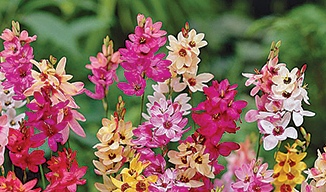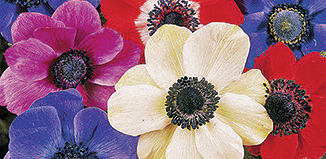
Most spring-flowering bulbs can be planted from mid-February through to May. Choose a sunny spot – most spring bulbs need at least half a day of sun to flower happily, and loosen soil with a fork before planting. If you have heavy clay, dig sand or compost into the top layer of soil and, as a general rule, plant 2-3 times as deep as the height of the bulb. Water the ground thoroughly after planting.
Daffodils are the easiest and cheeriest bulbs to grow. Find a place with plenty of light – you can plant them under deciduous trees however as most of their growth is complete by the time the trees are in full leaf. If they’re competing with tree roots, give them additional water and fertiliser.
The key to success with these bulbs is perfect drainage – if soil is too wet, particularly during summer when soil is warm, bulbs may rot (obviously this won’t be a problem this summer!)
Daffs are not heavy feeders – mix bulb food into soil before planting and once again as leaves emerge from the soil. Avoid throwing it into the bottom of your hole as new roots can be killed by high concentrations of fertiliser.
‘Paperwhites’ and ‘Erlicheer’ are among my favourites, probably because they are so early to flower, when we are still in the depths of winter. However I also treasure the little ‘Tete a Tete’ mini daffodils. These cuties grow to 15cm tall and each stem can carry up to three deep-yellow flowers in late winter – great in a big, wide terra-cotta bowl.
 Early planting of anemones and ranunculi will produce winter flowers, later planting will give spring blooms. To encourage good germination and flower production, place your corms in the fridge prior to planting (four weeks for ranunculi and six for anemones). I find soaking the corms in tepid water (for a few hours or even overnight) before planting out helps break dormancy. Remember, anemones are planted pointy side down, ranunculi claws are also planted downwards. Both these bulbs are heavy feeders – use a general purpose fertiliser once a month and keep well watered.
Early planting of anemones and ranunculi will produce winter flowers, later planting will give spring blooms. To encourage good germination and flower production, place your corms in the fridge prior to planting (four weeks for ranunculi and six for anemones). I find soaking the corms in tepid water (for a few hours or even overnight) before planting out helps break dormancy. Remember, anemones are planted pointy side down, ranunculi claws are also planted downwards. Both these bulbs are heavy feeders – use a general purpose fertiliser once a month and keep well watered.
Dutch irises are easy to grow provided they have fertile, well-drained soil and ixias enjoy a sunny spot in free-draining soil. The brightly coloured flowers can last up to two weeks in a vase so they’re well worth considering if you have a picking garden.

This autumn I’m planning to plant gladioli, not the gawky summer-flowering variety, but the easy-care, spring-flowering, type in my garden. True to their South African heritage, they need well-drained soil and sun. The ‘Gladiolus nanus miniature’ hybrids come in a range of colours, but being a lover of white flowers with a hint of green, I think I’ll be picking the elegant ‘Gladioli colvillei alba’ (The Bride).
When flowering of your spring bulbs has finished, snip off stems but wait until foliage dies down naturally before cutting back plants. At this time bulbs are busy storing their own food reserves so they can flower again the next season.

